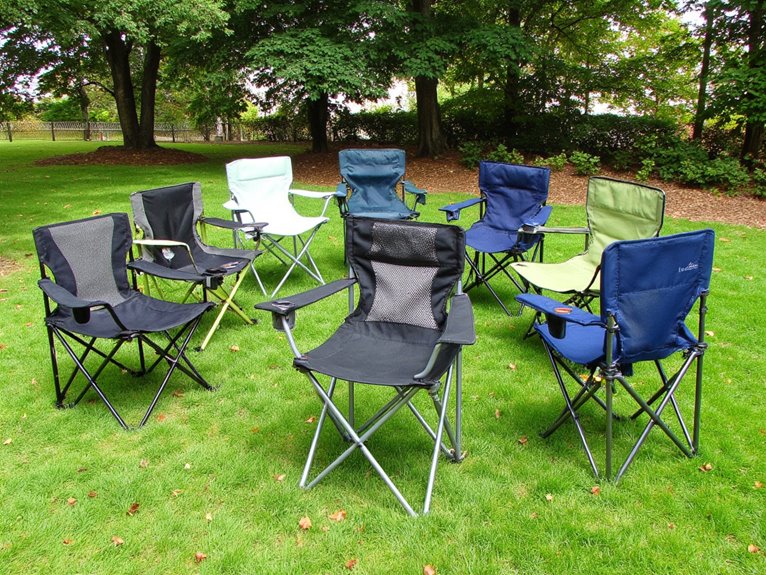10 Best Budget Sleeping Bags for Backpacking That Won’t Break the Bank
I’ve found that the best budget backpacking sleeping bags under $100 deliver genuine performance when you add 25-30°F to their temperature ratings. Top performers like the Teton 20F Mummy and Naturehike Ultralight Down weigh under 3 pounds while compressing to 11 inches. The ZOOOBELIVES at 27 ounces offers exceptional packability, while synthetic options like iClimb’s 3M Thinsulate excel in damp conditions. These selections prove you don’t need premium prices for reliable warmth and durability on the trail.
We are supported by our audience. When you purchase through links on our site, we may earn an affiliate commission, at no extra cost for you. Learn more. Last update on 14th December 2025 / Images from Amazon Product Advertising API.
Notable Insights
- Add 25-30°F to manufacturer temperature ratings for realistic comfort expectations, as budget bags often underperform advertised limits.
- Target sleeping bags weighing 1-4.6 pounds that compress to 11 inches for optimal backpacking weight and pack space.
- Choose synthetic fills for wet conditions or down insulation for better warmth-to-weight ratios in dry environments.
- Select mummy designs for maximum heat efficiency while considering potential movement restrictions compared to rectangular bags.
- Budget bags excel in 32-50°F conditions but require gear upgrades for reliable performance below freezing temperatures.
Teton 20F and 5F Degree Lightweight Mummy Sleeping Bag
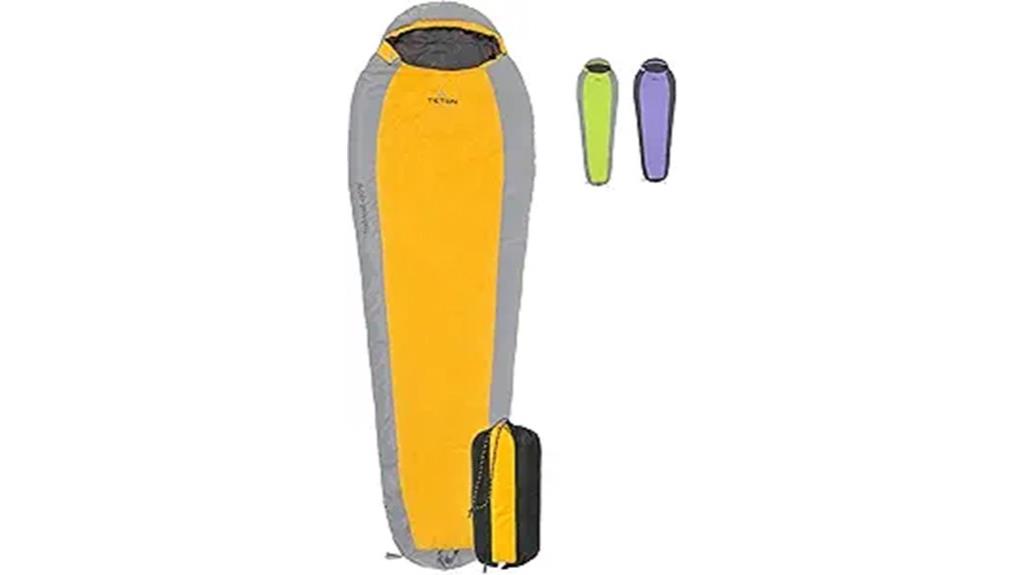
The Teton Sports sleeping bag delivers exceptional warmth-to-weight ratio that makes it ideal for budget-conscious backpackers who refuse to compromise on cold-weather protection. At 8.2 pounds, it’s heavier than ultralight options but provides reliable thermal performance down to 5°F survival rating.
You’ll appreciate the PolarLite insulation‘s body mapping design that eliminates cold spots through double-layer construction. The mummy hood seals around your head while zipper draft tubes prevent heat loss. Measuring 87 x 63 x 3 inches, it accommodates larger frames comfortably.
The included compression sack simplifies transport, though you shouldn’t machine wash this bag. With 4.3 stars from 6,876 reviews and a lifetime warranty, it’s proven reliable for three-season backpacking when weight isn’t your primary concern.
Best For: Budget-conscious backpackers and campers who prioritize warmth and comfort over ultralight weight for three-season outdoor adventures.
Pros:
- Excellent warmth-to-weight ratio with reliable thermal performance down to 5°F survival rating
- Spacious mummy design accommodates larger frames while maintaining heat efficiency through body mapping technology
- Strong value proposition with lifetime warranty coverage and proven durability based on extensive user reviews
Cons:
- At 8.2 pounds, significantly heavier than ultralight backpacking sleeping bags
- Cannot be machine washed, requiring more careful maintenance and cleaning procedures
- Weight makes it less suitable for ultralight backpacking where every ounce matters
iClimb 3M Thinsulate Insulation Mummy Sleeping Bag with Compression Sack
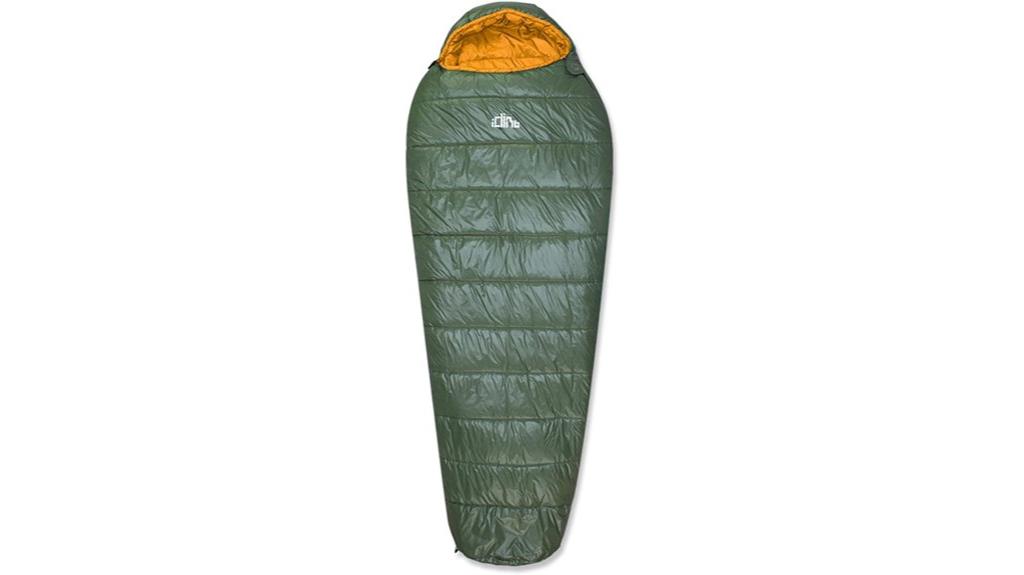
Backpackers seeking maximum warmth-to-weight efficiency will find the iClimb 3M Thinsulate Insulation Mummy Sleeping Bag delivers exceptional performance at just 3 pounds. The 20D nylon shell houses 3M Thinsulate insulation that traps body heat while allowing moisture to escape. You’ll stay comfortable down to 35°F, with survival limits extending to 27°F.
The anatomically designed 3D footbox eliminates cramped toes. Double-layer construction minimizes cold spots throughout the bag. A cinchable draft collar prevents heat loss around your neck and shoulders.
When packed, it measures 15.7″ × 9″, compressing further to 9.8″ × 9″ for tight pack spaces. The 82″ length accommodates users up to 6’10”. User ratings average 4.6 stars across 86 reviews.
Best For: Backpackers and hikers who prioritize lightweight gear and need reliable warmth for three-season camping in moderate conditions down to 35°F.
Pros:
- Exceptional warmth-to-weight ratio at only 3 pounds with 3M Thinsulate insulation that manages moisture while retaining heat
- Highly packable design compresses to 9.8″ × 9″ and includes anatomically designed 3D footbox for comfort
- Generous sizing accommodates users up to 6’10” with strong user satisfaction averaging 4.6 stars
Cons:
- Some users report zipper reliability issues based on customer feedback
- Small pillow pocket may not accommodate larger pillows comfortably
- Limited to moderate temperature conditions with comfort rating only down to 35°F
Naturehike Ultralight Backpacking Down Sleeping Bag for Adults
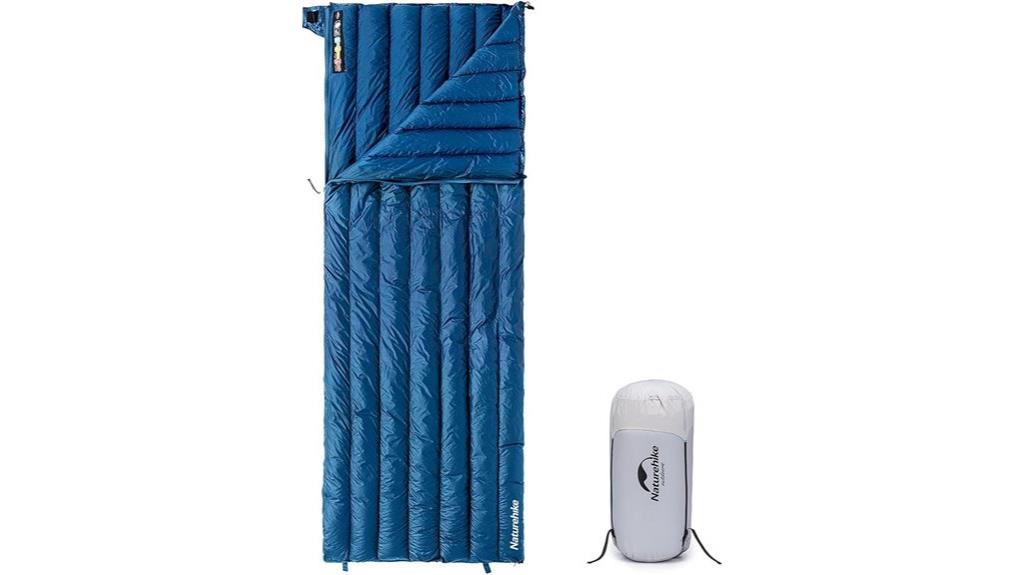
When gram-counting becomes critical on multi-day adventures, Naturehike’s Ultralight Backpacking Down Sleeping Bag delivers exceptional warmth-to-weight performance at just 20 ounces. You’ll appreciate the 650 fill power duck down insulation with 295g fill weight, providing comfortable warmth between 42-52°F. The bag compresses to just 4.7 x 10.2 inches when stowed.
The individual down channel design prevents shifting while maintaining consistent insulation. You get two size options: medium (74.8″ x 28.3″) or large (78.74″ x 31.50″). The 20D 400T nylon shell offers durability without excess weight. YKK two-way zippers enable coupling with another bag, while the elasticized neck opening minimizes heat loss for peak thermal efficiency.
Best For: Ultralight backpackers and hikers who need a compact, lightweight sleeping bag for 3-season camping in temperatures above freezing.
Pros:
- Exceptional weight-to-warmth ratio at just 20 ounces with 650 fill power down insulation
- Compresses to an ultra-compact 4.7 x 10.2 inches for easy packing
- High-quality construction with YKK zippers, individual down channels, and durable 20D nylon shell
Cons:
- Limited to warmer weather use with comfort rating only down to 42°F
- Can feel tight around shoulders according to user feedback
- Lacks sufficient cinch cord options for customizing fit and ventilation
ECOOPRO Warm Weather Sleeping Bag – Portable, Waterproof & Lightweight

Budget-conscious adventurers seeking reliable warm-weather protection will find exceptional value in the ECOOPRO Warm Weather Sleeping Bag. This lightweight option weighs just 1.45 pounds and measures 83L x 30W inches, accommodating adults under six feet tall. You’ll appreciate its compact 11-inch packed size for backpacking trips.
The bag’s nylon outer shell provides waterproof protection, while the 100% polyester interior offers breathable comfort. It’s rated for temperatures between 55-60°F, making it ideal for spring and summer camping. With 8,468 reviews averaging 4.4 stars, you’re getting proven performance at budget pricing for warm-weather adventures.
Best For: Budget-conscious campers and backpackers who need a lightweight, compact sleeping bag for warm weather camping in temperatures above 55°F.
Pros:
- Extremely lightweight at 1.45 lbs with compact 11-inch packed size ideal for backpacking
- Waterproof nylon exterior with breathable polyester interior for comfort in warm conditions
- Excellent value with strong customer ratings (4.4/5 stars from over 8,000 reviews) and #4 ranking in camping sleeping bags
Cons:
- Limited temperature range (55-60°F) makes it unsuitable for cold weather or winter camping
- Tight fit for broad-shouldered individuals and those over 6 feet tall
- Not truly waterproof according to some customer feedback, with potential durability issues over time
MalloMe Sleeping Bags for Adults Cold Weather & Warm
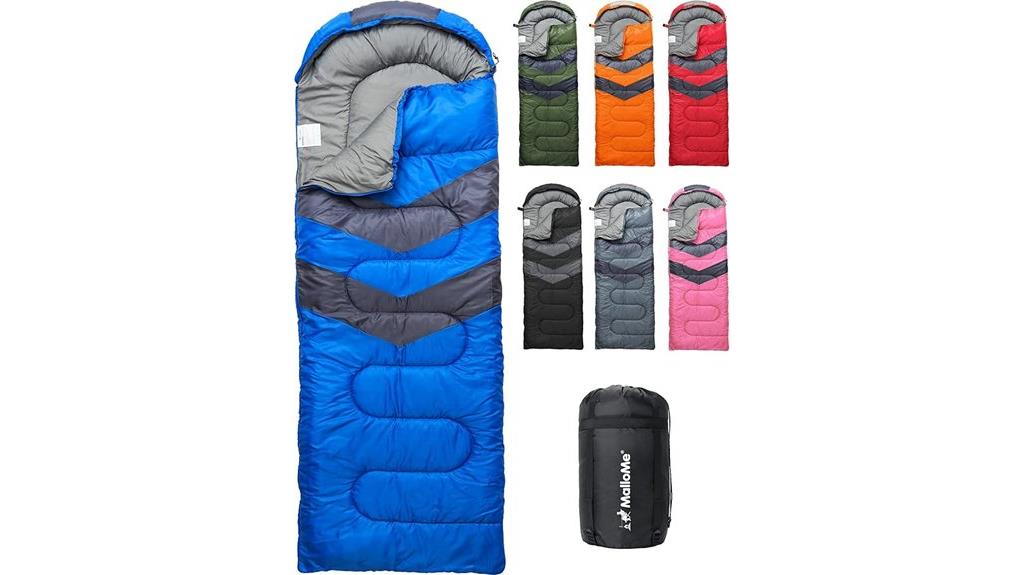
Three-season adventurers seeking reliable warmth without breaking the bank will find exceptional value in the MalloMe Sleeping Bags for Adults Cold Weather & Warm. This rectangular bag measures 86.6L x 31.5W inches and weighs approximately 3 pounds, accommodating adults up to 6 feet tall. The temperature rating spans 50°F to 77°F, making it versatile for spring, summer, and fall conditions.
The hex-tech waterproof outer shell protects against moisture while enabling easy cleaning with a damp cloth. Inside, 3D synthetic fiber insulation provides consistent warmth retention. Double-sided, snag-free zippers paired with velcro straps guarantee secure closure and temperature control through adjustable drawstrings.
Best For: Three-season campers, hikers, and backpackers who need a budget-friendly sleeping bag for temperatures between 50°F to 77°F and want easy maintenance with waterproof protection.
Pros:
- Waterproof hex-tech outer shell with easy cleaning and 3D synthetic fiber insulation for reliable warmth retention
- Lightweight at 3 pounds with compression sack for compact storage and transport
- Double-sided snag-free zippers with velcro straps and drawstrings for secure closure and temperature adjustment
Cons:
- Some users report zipper durability issues with extended use
- Storage bag quality receives complaints from customers
- Factory packaging smell requires washing before first use
TETON Sports LEEF Ultralight Mummy Sleeping Bag for Backpacking & Camping

The TETON Sports LEEF Ultralight Mummy Sleeping Bag delivers exceptional warmth-to-weight performance for backpackers who refuse to compromise on comfort. At 4.6 pounds, it offers three temperature ratings: 0°F, 20°F, and 30°F. However, you’ll want to add 25-30°F to these ratings for realistic comfort expectations.
The bag measures 87 x 30 x 3 inches and compresses to 17 x 11 x 11 inches in the included stuff sack. PolarLite Micro Insulation provides reliable warmth retention, while the durable polyester shell resists wear and sheds debris effectively. You’ll appreciate the mummy design’s heat efficiency without feeling claustrophobic. Available in short, regular, and long sizes for ideal fit.
Best For: Backpackers and campers who prioritize warmth and comfort over ultra-lightweight gear and need a reliable sleeping bag for 3-4 season use.
Pros:
- Excellent warmth-to-weight ratio at 4.6 pounds with effective PolarLite Micro Insulation and heat-retaining mummy design
- Durable polyester construction that resists wear and sheds debris, backed by a lifetime warranty against defects
- Multiple size options (short, regular, long) and temperature ratings (0°F, 20°F, 30°F) with high user satisfaction ratings
Cons:
- Temperature ratings are overstated – requires adding 25-30°F to manufacturer ratings for realistic comfort expectations
- Bulky packed size (17 x 11 x 11 inches) may not fit in smaller backpack compartments and could require gear upgrades
- Manufacturer recommends against washing which may void warranty, limiting cleaning and maintenance options
ZOOOBELIVES Ultralight Down Sleeping Bag for Backpacking and Camping
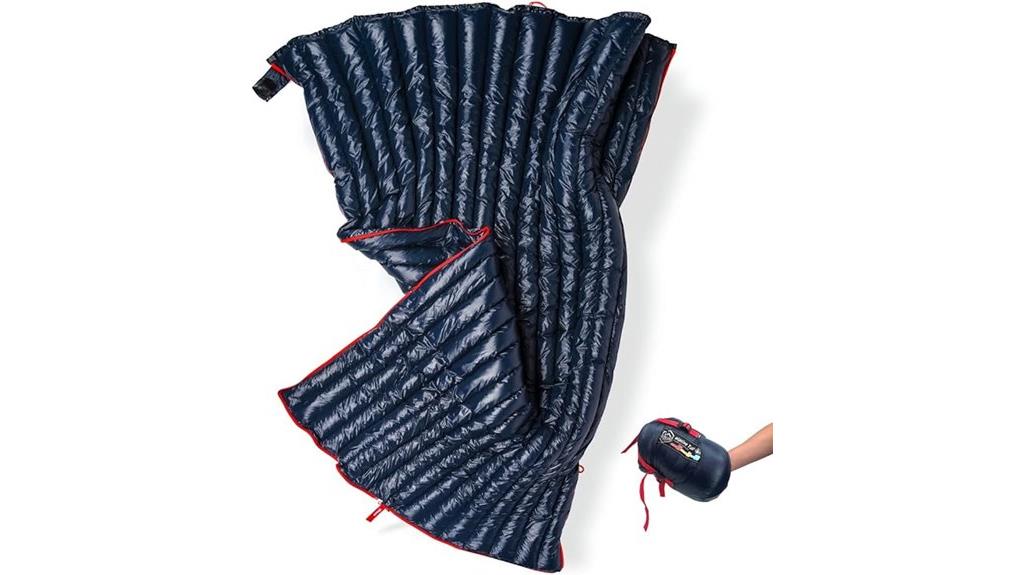
Ultralight backpackers who prioritize weight savings without sacrificing warmth will find exceptional value in the ZOOOBELIVES Alplive T400 sleeping bag. At just 27 ounces, this down-filled bag packs to 11″ x 6.7″ dimensions. The 650-fill duck down provides excellent warmth-to-weight ratio for temperatures between 32-50°F. You’ll appreciate the rectangular shape that allows movement freedom and can zip to another bag for couples. The 20D nylon shell features durable water-repellent treatment. Two YKK zippers enable foot ventilation and full unzipping for blanket use. With 4.2-star ratings across 804 reviews, users consistently praise its compactness and summer camping performance.
Best For: Ultralight backpackers and summer campers who need a lightweight, compressible sleeping bag for temperatures between 32-50°F and value the versatility of converting to a blanket or coupling with another bag.
Pros:
- Exceptional weight-to-size ratio at just 27oz and packs down to 11″ x 6.7″ dimensions
- Versatile design with foot ventilation zipper, full blanket conversion, and ability to zip with another bag
- High-quality construction featuring 650-fill duck down, water-repellent 20D nylon shell, and reliable YKK zippers
Cons:
- Temperature rating may be optimistic and primarily suitable for summer conditions only
- Limited warmth for colder weather camping below 32°F
- Duck down insulation may lose loft when exposed to moisture despite water-repellent treatment
Naturehike Lightweight Sleeping Bag – Compact & Waterproof for 3 Season Camping
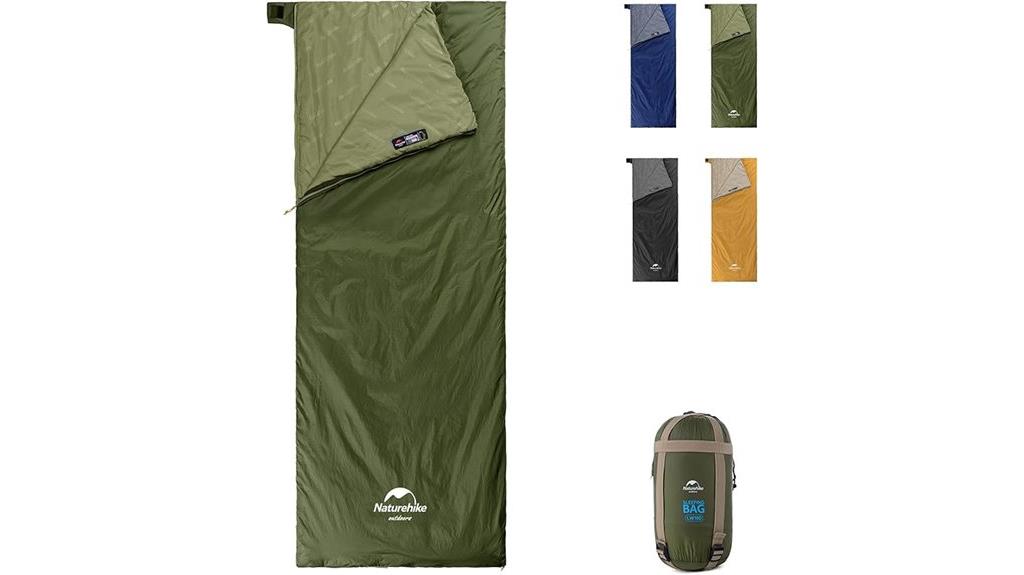
Backpackers seeking ultralight gear without breaking the bank will find exceptional value in the Naturehike Lightweight Sleeping Bag, which delivers impressive portability at just 815 grams (28oz) including its 55-gram stuff sack. You’ll appreciate how it compresses to roughly the size of a Nalgene bottle using its efficient strap system. The waterproof exterior and quality zipper construction make it suitable for three-season use above 60°F. However, you shouldn’t rely on manufacturer temperature ratings—user experiences show it performs poorly below 55°F. It accommodates side sleepers up to 6’0″ and 175 lbs comfortably, making it ideal for summer backpacking when weight matters more than extreme cold protection.
Best For: Summer backpackers and hikers who prioritize ultralight gear for warm weather camping above 60°F and need a compact, budget-friendly sleeping bag.
Pros:
- Extremely lightweight at 815 grams and compresses to the size of a Nalgene bottle for excellent portability
- Waterproof exterior with quality zipper construction provides reliable weather protection
- Comfortable for side sleepers up to 6’0″ and 175 lbs with good roominess and loft
Cons:
- Poor performance in temperatures below 55-60°F despite manufacturer’s three-season claims
- Inadequate insulation for high-altitude or colder environments without additional layers
- Temperature ratings are unreliable and misleading compared to actual user experiences
0 Degree Winter Sleeping Bags for Adults Camping (450GSM)
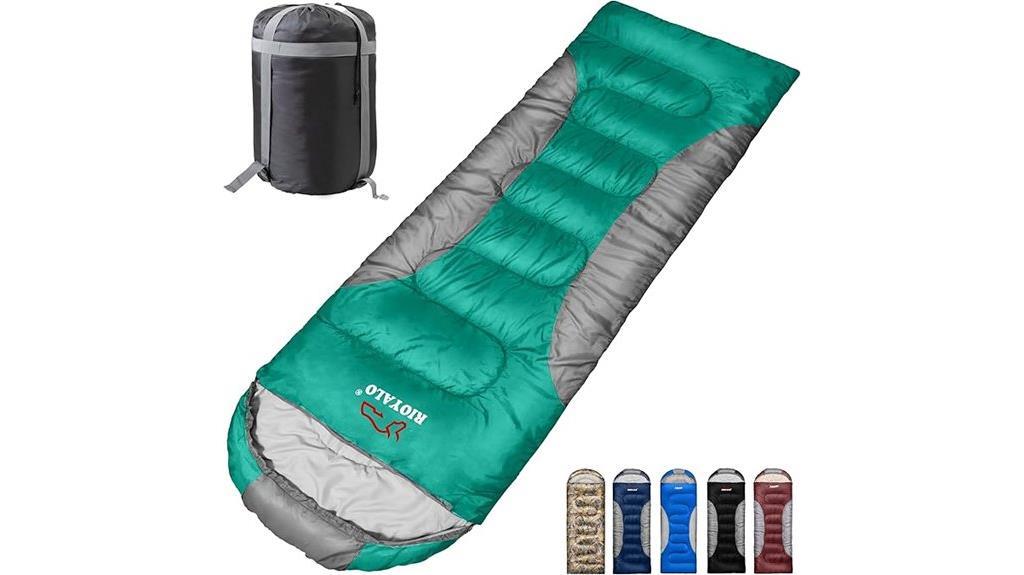
Winter campers operating in sub-freezing conditions will find the 0 Degree Winter Sleeping Bag (450GSM) delivers exceptional warmth-to-weight performance at 5 pounds. The rectangular design with hood accommodates extra-large frames while the 450GSM polyester filling maintains thermal efficiency in temperatures ranging from 5°F to 32°F. You’ll appreciate the 210T nylon ripstop exterior paired with 190T pongee lining for durability and comfort. The waterproof construction prevents heat loss from moisture infiltration. Wind buffers and anti-pinch zipper ribbons enhance functionality during harsh conditions. At 2,394 user ratings averaging 4.4 stars, this bag proves effective for four-season camping despite some reported fit concerns.
Best For: Winter campers, hikers, and outdoor enthusiasts who need reliable warmth in sub-freezing temperatures from 5°F to 32°F while prioritizing a lightweight, durable sleeping bag for four-season camping adventures.
Pros:
- Excellent warmth-to-weight ratio at 5 pounds with 450GSM polyester filling that maintains thermal efficiency in extreme cold conditions
- Durable waterproof construction with 210T nylon ripstop exterior and thoughtful features like wind buffers and anti-pinch zipper ribbons
- Versatile rectangular design with hood accommodates extra-large frames and includes convenient features like internal device pocket and machine washable materials
Cons:
- Some users report fit tightness issues that may compromise optimal warmth retention and comfort
- Limited cinching abilities may reduce effectiveness in sealing out cold air during extreme weather conditions
- At 5 pounds, it may be heavier than ultralight alternatives preferred by minimalist backpackers
Ultralight Down Sleeping Bag for Adults with Compression Sack

When you’re counting every ounce on the trail, this 1.36-pound sleeping bag delivers three-season comfort without breaking your budget or your back. The 600 fill power down insulation keeps you warm in temperatures from 45°F to 68°F. You’ll get 260g of duck down wrapped in tear-resistant 400T 20D nylon that’s both waterproof and windproof.
The mummy design measures 84.6 x 31.5 inches when deployed but compresses to just 10.2 x 6.7 inches. You’ll appreciate the trapezoidal foot box that prevents cramped toes during long nights. The compression sack makes packing effortless, though some users report the fabric requires careful handling to prevent tears.
Best For: Ultralight backpackers and hikers who need a compact, lightweight sleeping bag for three-season camping in moderate temperatures above 45°F.
Pros:
- Exceptionally lightweight at 1.36 lbs with excellent compressibility (10.2 x 6.7 inches packed)
- Quality 600 fill power duck down insulation provides warmth without bulk
- Waterproof and windproof 400T 20D nylon shell with thoughtful design features like trapezoidal foot box
Cons:
- Limited to warmer conditions with minimum temperature rating of only 45°F
- Fabric requires careful handling as some users report potential for tears
- Higher temperature range (45°F-68°F) restricts use to three-season camping only
Factors to Consider When Choosing Budget Sleeping Bags for Backpacking
When I evaluate budget sleeping bags for backpacking, I focus on five critical factors that directly impact your comfort and performance on the trail. Temperature ratings must accurately reflect real-world conditions since your safety depends on staying warm, while weight and packability determine how much space the bag consumes in your pack. I’ll examine each factor’s role in maximizing value within budget constraints, from fill materials and durability trade-offs to proper sizing for ideal thermal efficiency.
Temperature Rating Accuracy
Although sleeping bag temperature ratings provide a starting point for selection, they don’t tell the complete story about real-world performance. I’ve found that budget sleeping bags often perform inconsistently compared to their advertised limits. Your metabolism, clothing layers, and sleeping position considerably impact actual warmth levels.
Most manufacturers provide comfort and extreme ratings. The comfort rating indicates ideal sleeping temperatures, while the extreme rating represents survival conditions—not comfortable sleep. I recommend adding 25-30°F to any temperature rating for reliable performance, especially with budget options.
Budget bags frequently struggle in colder conditions. Many users report adequate performance only 5-15°F above stated limits. This variance stems from cost-cutting measures in insulation quality and construction. Always consider your personal warmth preferences and local climate conditions when evaluating temperature specifications.
Weight and Packability
Weight becomes your constant companion on every mile of trail, making it a decisive factor in sleeping bag selection. I recommend targeting bags between 1 to 4.6 pounds for ideal backpacking performance. This range prevents excessive fatigue during extended hikes while maintaining necessary warmth.
Packability matters equally. Quality budget bags compress to water bottle dimensions—approximately 11 inches tall when stuffed. Look for sleeping bags featuring 20D nylon shells with synthetic insulations like 3M Thinsulate. These materials deliver excellent warmth-to-weight ratios without premium down pricing.
Compression technology maximizes your pack space. Modern budget designs utilize innovative construction methods that squeeze bags into compact cylinders. Check the stuff sack dimensions before purchasing. A sleeping bag that won’t compress properly wastes valuable backpack real estate you’ll need for food and gear.
Fill Material Options
Your sleeping bag’s fill material determines both performance and price point in budget backpacking gear. Synthetic fills like polyester and 3M Thinsulate offer water resistance and consistent warmth in damp conditions. They’re lighter than traditional down while maintaining insulation when wet.
Down insulation provides superior warmth-to-weight ratios with excellent compressibility. Look for 650+ fill power ratings for ideal loft performance. However, down loses insulating properties when wet unless specially treated.
Budget options often feature lower-quality fills or material blends that compromise warmth retention and durability. Synthetic fills excel in humid environments, while down performs best in dry conditions but requires careful maintenance.
Weight directly impacts packability. Lighter synthetics and quality down minimize gear weight without sacrificing thermal efficiency—crucial for backpackers prioritizing weight reduction.
Durability Vs Price
When evaluating budget sleeping bags, durability directly correlates with construction quality and material specifications that determine long-term value. I recommend examining outer fabric denier ratings, zipper quality, and fill materials before purchasing. Budget models often use lower-grade components that compromise longevity in harsh conditions.
Higher fill power insulation costs more initially but delivers superior warmth-to-weight ratios and extended lifespan. Many budget bags last only one season under frequent use without proper maintenance. Consider your usage frequency when calculating total ownership costs. A $150 bag lasting five seasons costs less than replacing $50 bags annually.
Look for manufacturer warranties or satisfaction guarantees. These indicate confidence in product durability relative to price points. Quality construction features like reinforced stress points and YKK zippers justify higher costs for serious backpackers.
Size and Fit
Three critical measurements determine whether a budget sleeping bag will provide comfortable rest during backpacking trips: length, width, and shape configuration. Most bags range from 82 to 87 inches in length, with specialized options accommodating individuals up to 6’10”. I recommend measuring your height and adding 6 inches for ideal comfort.
Shape notably impacts thermal efficiency. Mummy bags offer superior heat retention through their tapered design but restrict movement. Rectangular bags provide generous space—up to 30 inches wide—but sacrifice warmth retention.
Internal width affects sleep quality dramatically. Narrow bags suit smaller frames and maximize warmth. Wider configurations accommodate larger individuals or restless sleepers who need movement room. Consider your sleeping style when selecting dimensions, as cramped conditions compromise rest quality during multi-day backpacking adventures.
Frequently Asked Questions
How Do I Properly Clean and Maintain My Budget Sleeping Bag?
I’ll wash your sleeping bag in cold water on gentle cycle with mild detergent. I’d recommend air-drying it flat, storing it uncompressed, and spot-cleaning stains immediately to extend its lifespan considerably.
Can Budget Sleeping Bags Be Repaired if They Get Torn or Damaged?
I can definitely repair most tears and damage in budget sleeping bags. I’ll use fabric patches, seam sealer, or duct tape for quick fixes. Many manufacturers also offer repair kits specifically designed for their products.
What’s the Average Lifespan of an Affordable Backpacking Sleeping Bag?
I’ve found affordable backpacking sleeping bags typically last 3-5 years with regular use. If you’re careful with storage and maintenance, you’ll extend their lifespan considerably compared to rough handling and poor care.
Are Budget Sleeping Bags Safe for Solo Backpacking in Remote Areas?
I’d say budget sleeping bags can be safe for solo remote backpacking if you choose wisely. You’ll want proper temperature ratings, quality zippers, and reliable materials. I’d recommend testing gear beforehand and carrying backup warmth options.
How Do I Store My Sleeping Bag Long-Term Without Damaging It?
I’ll store my sleeping bag uncompressed in a large cotton sack or hanging loosely in a closet. I won’t keep it stuffed in its compression sack, as that’ll damage the insulation’s loft over time.
On a final note
I’ve presented eight sleeping bags that deliver solid performance without emptying your wallet. Each option offers specific advantages: the Teton bags excel in cold conditions, while Naturehike models prioritize weight reduction. Your choice depends on temperature ratings, packed size, and weight requirements for your trips. Don’t compromise on insulation quality or durability to save money. Test your bag’s comfort rating before heading into challenging conditions.

